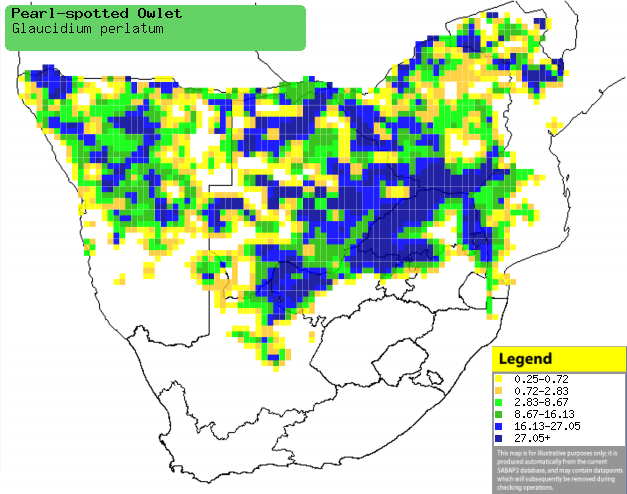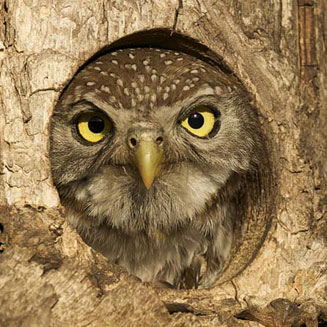|
Glaucidium perlatum
(Pearl-spotted owlet, Pearl-spotted owl)
Witkoluil [Afrikaans]; iNkovana [Zulu]; Kakuru
(also applied to other owl species) [Kwangali]; Zizi (generic name
for owl) [Shona]; Mankhudu (also applied to African wood-owl)
[Tsonga]; Lerubisana (applied to a number of other owl species)
[Tswana]; Geparelde dwerguil [Dutch]; Chevêchette perlée [French];
Perlkauz [German]; Mocho-perlado [Portuguese]
Life
> Eukaryotes >
Opisthokonta
> Metazoa (animals) >
Bilateria >
Deuterostomia > Chordata >
Craniata > Vertebrata (vertebrates) > Gnathostomata (jawed
vertebrates) > Teleostomi (teleost fish) > Osteichthyes (bony fish) > Class:
Sarcopterygii (lobe-finned
fish) > Stegocephalia (terrestrial
vertebrates) > Tetrapoda
(four-legged vertebrates) > Reptiliomorpha > Amniota >
Reptilia (reptiles) >
Romeriida > Diapsida > Archosauromorpha > Archosauria >
Dinosauria
(dinosaurs) > Saurischia > Theropoda (bipedal predatory dinosaurs) >
Coelurosauria > Maniraptora > Aves
(birds) >
Order: Strigiformes
> Family: Strigidae
The Pearl-spotted owlet is common in many parts of
Southern Africa, where it can be found in open woodland, thorn savannah and bushveld. Unlike most owls,
it hunts in the day as well as the night, feeding
mainly on invertebrates, with small mammals and birds making up most of the
remainder of its diet. It mainly nests in tree holes, usually made by barbets or
woodpeckers. It lays 2-4 eggs, which are
incubated mainly by the female. Once hatched, chicks stay in the nest for 27-32
days, after which they live in bushes nearby, being fed by their parents for at
least 14 days longer.
Distribution and habitat
Occurs in sub-Saharan Africa, excluding equatorial lowland
forest and desert. Within southern Africa it is common in northern and central
Namibia, Botswana, Zimbabwe, Mozambique and northern South Africa. It generally
prefers open thorn savanna, bushveld and sparse woodland, avoiding open grassland, shrubland and dense forests.
|
 |
|
Distribution of Pearl-spotted owlet in southern Africa,
based on statistical smoothing of the records from first SA Bird Atlas
Project (©
Animal Demography unit, University of
Cape Town; smoothing by Birgit Erni and Francesca Little). Colours range
from dark blue (most common) through to yellow (least common).
See here for the latest distribution
from the SABAP2. |
Food
Strangely for an owl, it hunts
opportunistically in the day as well as the night. It eats mainly invertebrates,
supplemented with small birds, mammal, reptiles and amphibians. It often flicks
or wags its tail and bobs its head up and down when excited about hunting. The
following food items have been recorded in its diet:
- Invertebrates
- Vertebrates
- birds
- mammals
- reptiles
- amphibians
- Other
- robs other birds of their prey.
- carrion
- Trichilia emetica (Natal mahogany) fruit
Breeding
 |
|
|
Pearl-spotted owlet peeping out of its nest,
Roodeplaatdam Dam, South Africa. [photo Johann Grobbelaar
©] |
|
- Egg-laying season is from August-November, peaking from September-October.
- It lays 2-4 eggs, which are incubated mainly done by the female for 28-29 days.
The male occasionally takes
over so that the female can have a break.
- The chicks stay in the nest for 27-31 days, after which they live near
the nest in dense bush, where they are fed by their parents for at least
another 14 days.
Threats
Not threatened, in fact common in many parts of southern
Africa.
References
-
Hockey PAR, Dean WRJ and Ryan PG (eds) 2005. Roberts
- Birds of southern Africa, VIIth ed. The Trustees of the John Voelcker
Bird Book Fund, Cape Town.
|
